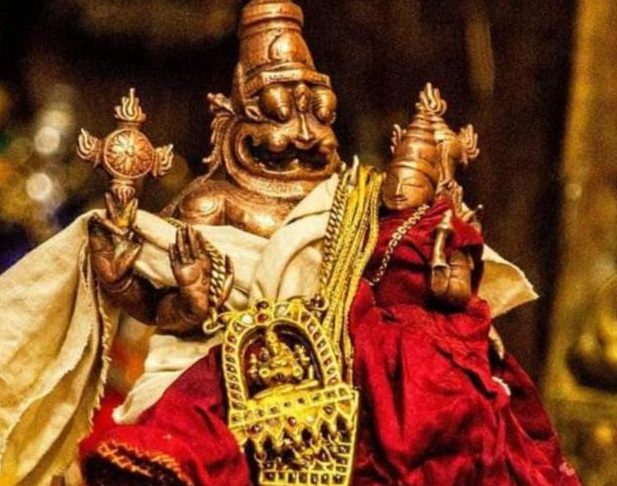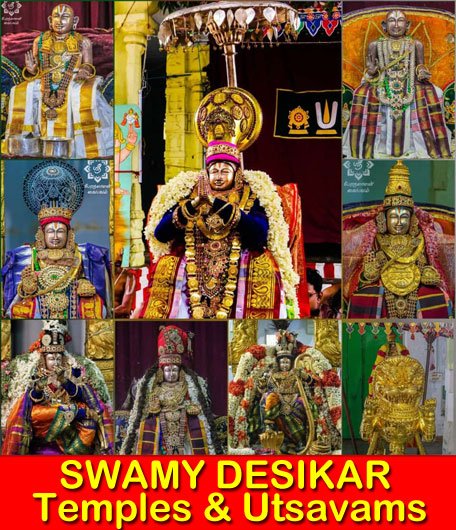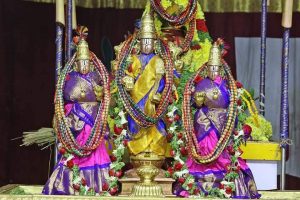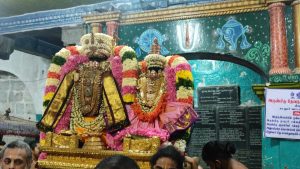TANIYAN – DEFINITION(தனியன்)
What is Taniyan (தனியன்) and its significance? Before undertaking an endeavour to study a traditional grantham, slokam or any similar composition, it is indeed our custom to invoke the blessings of the author and/or his reverent and sacred scriptures. In addition, a taniyan is chanted before conforming to a kalakshepam or upanyasam, whereby the benediction of the teacher is sought by the students. A taniyan is in the form of a slogan or a pasuram (பாசுரம்) in Tamil, hailing the auspicious attributes and noble qualities of a revered seer like the Azhwar (ஆழ்வார்) or other esteemed guru, who religiously initiated his sishyas to the righteous path. The taniyan is focusing on the fame of the opus and/or the qualities of the author.
In general, the taniyan slokam is in Anushtup (4 x 8 syllables), Shakvari (4 x 14 syllables) or Trishtup (4 x 11 syllables) metre. In Tamil religious scriptures, the commonly used styles for a taniyan pasuram are venba (வெண்பா) or Kattalai kalitthurai (கட்டளைக் கலித்துறை). A taniyan, literally translated as one, which stands alone, derives its title by the virtue of lauding the esteemed Acharya or Azhwar, or from the fact that it is distinct from a set of slokas or pasurams. It is our untainted faith and belief that chanting of the taniyan before studying and observing the reverent and traditional work of an Acharya or Azhwar, along with the taniyans of the poorvacharyas, will be a blessing-in-disguise for the devotees, besides the blessings of the author or the scripture who/which is appreciated by the taniyan, apart from the blessings of the poorvacharyas and through them the Almighty.
SWAMI’S TANIYAN
வேதாந்த லஷமணமுநே: பாதரேகாமயம் ஸதா
தததீன ப்ரவருத்யாதிம் ஹாரீதம் மாதவம் பஜே
2.1 Introduction
The above taniyan slokam in anushtup metre consists of four quarters, each having eight syllables, totalling to 32 syllables. The four quarters are mentioned as follows:
A வேதாந்த லஷமணமுநே :
Of his holiness Srimad Vedanta Ramanuja Mahadesika.
B பாதரேகாமயம் ஸதா:
Always like the lines abounding on the holy feet.
C தததீன ப்ரவருத்யாதிம்:
His propensity to act is dependent on it.
D ஹாரீதம் மாதவம் பஜே:
Our salutations unto Sri Madhavacharya belonging to Haritha Gothram.
Origin:
Swami is blessed to be graced by the benediction of his Acharya. His holiness Srimad Vedanta Ramanuja Mahadesikan (ஸ்ரீமத் திருக்குடந்தை ஆண்டவன் ஸ்வாமி), had composed the taniyan for Swami. What a rare and unique honour showered on him by his Acharya! The very fact that this taniyan was composed by his Acharya, demonstrates not only the affection and the compassion of the Acharya towards our seer, but also the deep-rooted contenment that the Acharya had towards our Swami for his knowledge, practice as the relentless Acharya emphasises on Bhagavatha Kainkaryam, too, while simultaneously recording his reflections on the intent of our seer.
In the original version of this taniyan, as composed by his holiness ஸ்ரீமத் திருக்குடந்தை ஆண்டவன் ஸ்வாமி, the fourth quarter was to be read as “Ramanuja Munim Bhaje”. However, this version of the taniyan was not disseminated at that time for generic consumption. When our Swami started delivering Sribhashya kalakshepa in Chennai, the sishyas desired to recite Swami’s taniyan before and after kalakshepam to get showered by the benedicton of our Swami and, accordingly, urged for his taniyan. At that time, Sri U.Ve. Villur Nadathur Dr Karunakaracharya Swami (உ.வே. வில்லூர் நடாதூர் கருணாகராசார்யார் ஸ்வாமி) modified the fourth quarter from the original version of “Ramanuja Munim Bhaje” to “Haaritham Madhavam Bhaje”. The modified version of the taniyan is in vogue and being recited by the sishyas.
Purport:
A The devotees would wish to pay their obeisance to Sri Madhavacharya Swami, who was born in the Haritha gothram, the same gothram, as that of Srimad Ramanujacharya. It is one of the reasons for the original version to be read as “Ramanuja Munim Bhaje”.
B Vedanta Lakshmanamune Padarekamayam Sada (வேதாந்த லஷமணமுநே: பாதரேகாமயம் ஸதா), where the last quarter described the action performed by the Sishyas, even though the first three quarters indicate the important virtues and attributes of our Swami. The literal meaning of the taniyan is that our Swami is always immersed and imbibed in the thoughts and divine teachngs that he received from his Acharya. His holineness Srimad Vedanta Ramanuja Mahadesika hails it, as it spread along his Acharya’s lotus feet.
There are several references, which relate to the Nithyasuris paying encomiums to the divine feet of the Lord. For example, Periyaywar (பெரியாழ்வார்) in his pasuram — “ஒரு காலில் சங்கு, ஒரு காலில் சக்கரம் உள்ளடி” (பெரியாழ்வார் திருமொழி) indicates that சங்கத்தாழ்வான் and சக்கரத்தாழ்வான் are interwined and connected to the lotus-feet of our Lord. Similarly, Srimad Yamunacharya says that the conch, the chakra, the flagstaff, the lotus, the goad and the vajra form the lines on the Lord’s feet. What the Nithyasuris are to the Lord, so was our Swami to his Acharya. Whereas the Lord uses Nithyasuri to perform important missions for him, ஸ்ரீமத் திருக்குடந்தை ஆண்டவன் ஸ்வாமி used our Swami for getting the work done.
Our Swami is always provided shelter under the auspices of the great seer’s lotus feet, akin to the shadow of his Acharya. It might not be a stretch to consider ஸ்ரீமத் திருக்குடந்தை ஆண்டவன் ஸ்வாமி to be an incarnation of the Lord. “What our Swami is” is left for the readers to interpret!
Thadadeena pravaratheeyathim (தததீன ப்ரவருத்யாதிம்) acts like a possession, a property and a subject, performing all his actions like daily practices, according to the caste and stage of life, leading his life as per vedic order, following and teaching the principles of righteousness, doing good for his disciples and community, as prescribed by his Acharya Srimad Thirukudandai Andavan Swami (ஸ்ரீமத் திருக்குடந்தை ஆண்டவன் ஸ்வாமி). Pursuing the mandate laid out in Seshasamhita, our Swami always thinks of his Acharya and spreads his fame among his disciples and elsewhere.
Based on several anecdotes, it is understood that the third and fourth quarters ‘Thathateena Pravaruthyathim’ (தததீன ப்ரவருத்யாதிம்) and ‘Ramanuja Munim Bhaje’ (ராமானுஜமுனிம் பஜே) were written by his Acharya with an alternate intend in is mind. Perhaps, Srimad Thirukudanthai Andavan Swami (ஸ்ரீமத் திருக்குடந்தை ஆண்டவன் ஸ்வாமி) had thought of our Swami as his successor in taking charge of sastra, administration and sishyas, among others. It is high time, we all worship and prostrate unto our Swami, the one with such auspicious virtues and qualities, as mentioned above. Above all, Swami belongs to the same gothram, as Srimad Ramanujacharya and the one named, “Madhava”.
…. More and the concluding article in part – 2)….
K.V








